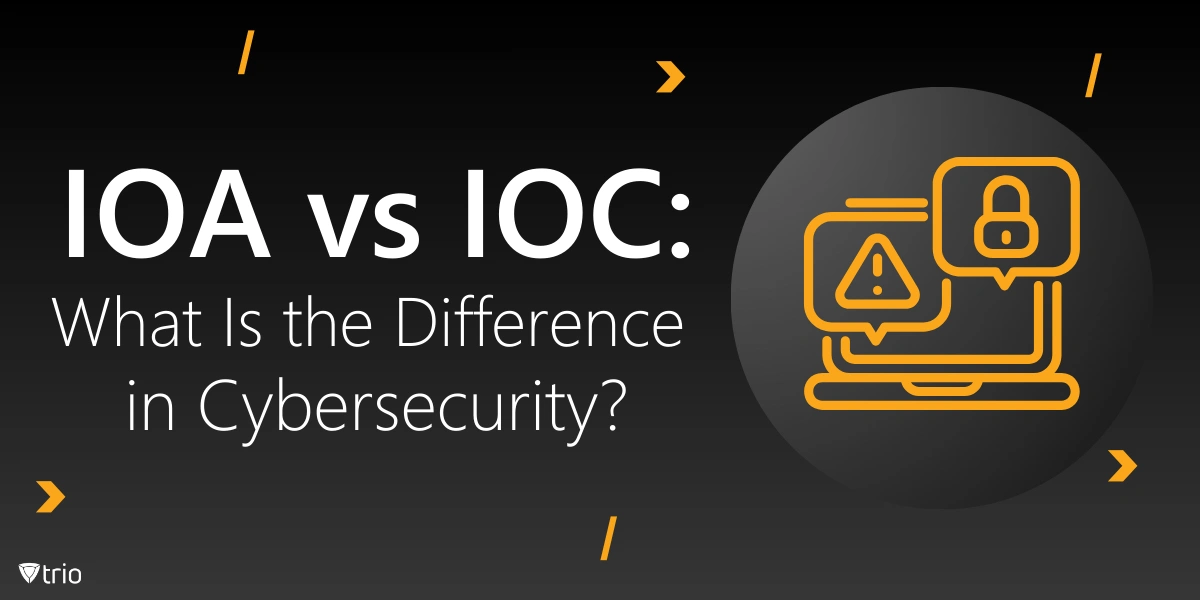As the world is getting more connected, the cybersecurity landscape is evolving at an unprecedented pace. Cyber threats are becoming more sophisticated, exploiting new vulnerabilities faster than organizations can patch them. This dynamic environment demands that companies stay ahead of the curve to protect their digital assets effectively.
Amidst this complexity, concepts like Indicators of Attack (IOA) and Indicators of Compromise (IOC) are crucial tools in vulnerability management. While they might sound similar, they play distinct roles in identifying and mitigating cyber threats. Learning about these concepts can help any organization aiming to bolster its security posture.
Grasping the difference between IOA and IOC isn’t just a technical exercise—it’s a strategic necessity. By distinguishing between these two types of indicators, organizations can implement more effective security measures that not only respond to incidents but also proactively prevent them.
What Is IOC in Cybersecurity?
Indicators of Compromise are digital artifacts that suggest a security breach, such as a data breach, has already occurred. They are the breadcrumbs left behind by cyber attackers, providing evidence that systems or data have been compromised. These indicators help security teams piece together the narrative of an attack after it has happened.
Common IOC examples include unusual network traffic patterns that don’t align with regular activity, signaling potential unauthorized access or data exfiltration. The sudden presence of malicious code or files on systems is another red flag. Additionally, unauthorized changes to system files can indicate that an attacker has altered configurations or implanted backdoors.
The role of IOC in cybersecurity is primarily reactive. They are used for post-incident analysis, helping organizations understand the extent and impact of a security breach. By examining IOCs, security professionals can identify compromised systems, assess damage, and initiate remediation efforts to prevent further exploitation.
By analyzing IOCs, organizations can improve their vulnerability management processes. Insights gained from previous attacks enable them to fortify defenses, patch vulnerabilities, and update security protocols. This continuous improvement cycle is vital for adapting to the ever-changing threat landscape.

What Is IOA in Cybersecurity?
Indicators of Attack are signs that an attack is currently in progress or imminent. Unlike IOCs, which are evidence of past breaches, IOAs focus on detecting attacker behaviors and tactics before they result in a compromise. This proactive approach is essential for thwarting threats like a zero-day attack that exploit unknown vulnerabilities.
Common IOA examples include unusual user behavior or access attempts, such as multiple failed login attempts or logins from unfamiliar locations. Anomalous application activities, like a program accessing files it doesn’t typically use, can also be indicative of an impending attack. Suspicious privileged account use, where administrative accounts perform unexpected actions, is another critical IOA to monitor.
The role of IOA in cybersecurity is to enable proactive detection and prevention of attacks. By identifying and responding to these indicators, organizations can intervene before attackers achieve their objectives. This approach minimizes potential damage and helps maintain the integrity and availability of systems and data.
Leveraging IOAs allows organizations to adopt a more proactive security stance. Instead of waiting for an attack to manifest, they can anticipate and neutralize threats in real-time. This shift from reactive to proactive defense is crucial in a landscape where attackers are constantly developing new methods to bypass traditional security measures.
Key Differences Between IOA and IOC
Now that we have an idea of what IOA and IOC are, let’s look at some of the differences between these two.
Timeframe of Detection
One of the primary differences between IOA and IOC lies in the timeframe of detection. IOC represents a reactive approach, where indicators are identified after a security breach has occurred. It involves analyzing the evidence left behind to understand and respond to the incident.
In contrast, IOA embodies a proactive approach, focusing on detecting signs of an attack during or even before it happens. By monitoring behavioral patterns, organizations can anticipate threats and take action to prevent them, effectively reducing the risk of compromise.
Nature of Indicators
The nature of the indicators also sets IOA and IOC apart. IOC consists of evidence-based artifacts left by attackers, such as altered files, malware signatures, or unusual network traffic logs. These tangible pieces of evidence are critical for forensic analysis post-incident.
IOA, however, centers on behavioral patterns indicating potential threats. It involves observing actions that deviate from normal operations, which could signify malicious intent. This behavioral analysis is key to detecting sophisticated attacks that might not leave traditional artifacts.
Response Strategies
When it comes to response strategies, IOC focuses on containment and remediation. After detecting IOCs, organizations aim to limit the damage, eradicate threats, and restore normal operations. This process can be time-consuming and costly, especially if the breach was extensive.
Conversely, IOA emphasizes prevention and immediate intervention. By acting on IOAs, organizations can stop attacks before they cause harm, saving resources and maintaining business continuity. This approach shows the importance of real-time monitoring and swift decision-making in cybersecurity.
The Importance of IOA and IOC in Cybersecurity Strategies
IOA and IOC play complementary roles in IT risk management. While IOA enables organizations to detect and prevent ongoing or imminent attacks, IOC provides valuable insights into past breaches. Together, they offer a comprehensive security framework that addresses both proactive and reactive aspects of cybersecurity.
By leveraging both indicators, organizations can significantly enhance their threat detection capabilities. IOA allows for early detection of malicious activities, while IOC helps in understanding and mitigating the impact of successful breaches. This dual approach ensures a more resilient defense against evolving threats.
Utilizing insights from IOA and IOC is crucial for optimizing your cybersecurity incident response plan. Understanding attacker behaviors and the artifacts they leave behind enables security teams to craft more effective response strategies. This knowledge ensures that organizations are better prepared to handle incidents swiftly and efficiently.
Implementing IOA and IOC in Security Practices
Implementing IOA and IOC requires the right technological tools. Security Information and Event Management (SIEM) systems play a vital role by aggregating and analyzing log data from various sources, helping detect anomalies in real-time. SIEM solutions provide the visibility needed to identify both IOAs and IOCs effectively.
Endpoint Detection and Response (EDR) solutions are equally important. They monitor end-user devices to detect suspicious activities, providing detailed information about potential threats. EDR tools are essential for identifying and responding to threats at the device level, where many attacks originate.
Adopting best practices is essential for maximizing the benefits of IOA and IOC. Regular monitoring and analysis of network activities help in early detection of threats. Employee training is crucial for raising awareness about suspicious activities, making your workforce an active part of your defense strategy.
Continuous updating of security protocols based on the latest IOA and IOC trends is another key practice. Staying informed about new attack vectors and threat indicators ensures that your data breach response plan remains effective. By proactively adjusting defenses, organizations can stay ahead of cyber adversaries.

Trio: Elevating Security With MDM Solutions
Mobile Device Management (MDM) is increasingly relevant in the context of IOA and IOC. As mobile devices become integral to business operations, they also represent potential entry points for cyber threats. MDM solutions like Trio help manage and secure these devices, ensuring that IOAs and IOCs are effectively monitored across all endpoints.
Trio’s MDM platform offers features that integrate seamlessly with your existing security infrastructure. By providing real-time monitoring and control over mobile devices, Trio enhances your ability to detect and respond to threats promptly. To see how Trio can elevate your cybersecurity strategy, we encourage you to try the free demo and explore its capabilities firsthand.
Conclusion: Optimizing Cybersecurity Measures
Understanding the significance of distinguishing between IOA and IOC is vital in developing a robust cybersecurity strategy. Recognizing how these indicators differ—and how they complement each other—enables organizations to implement both proactive and reactive security measures effectively.
Integrating both IOA and IOC into your security framework ensures a comprehensive defense against cyber threats. While IOA helps in preventing attacks before they happen, IOC provides critical insights for improving defenses after an incident. This balanced approach strengthens your overall security posture.
In an era where cyber threats are continually evolving, ongoing vigilance and adaptation are not just recommended—they are imperative. By staying informed and embracing both IOA and IOC, organizations can better protect themselves in the ever-changing cybersecurity landscape. The journey toward enhanced security is continuous, but with the right strategies and tools, it’s a journey well worth undertaking.
Get Ahead of the Curve
Every organization today needs a solution to automate time-consuming tasks and strengthen security.
Without the right tools, manual processes drain resources and leave gaps in protection. Trio MDM is designed to solve this problem, automating key tasks, boosting security, and ensuring compliance with ease.
Don't let inefficiencies hold you back. Learn how Trio MDM can revolutionize your IT operations or request a free trial today!




